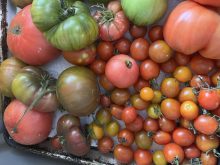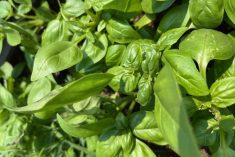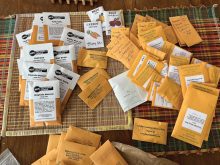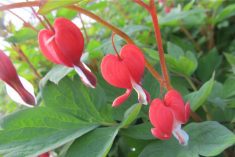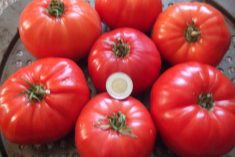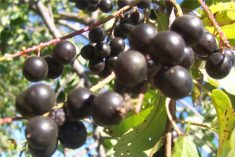My plum trees did me proud this year while in full bloom with hundreds of blossoms (see photo at top). There were so many flowers the trees couldn’t sustain them all and many never got pollinated. The good news is green plums about the size of large cranberries had formed up nicely as of mid-June.
I’m not surprised to discover that fruit trees are selling out twice as fast this year and sales of started vegetable plants and herbs are also way, way up at garden centres. More folks than ever are developing an appetite for gardening, self-sufficiency and building their own little corner of heaven on earth. Some are also sticking closer to home this year and taking shorter vacations or none at all because of the economy, inflation, high food prices, a high variety of taxes and various other reasons. It’s important to teach our children gardening skills and techniques they’ll never forget and carry with them through into adulthood. Back to nature has settled in stronger than ever and I’m included. I know folks who love their gardens so much they can hardly wait to get home from work and get into the garden.
Read Also

Gentle treatments for pain in the neck
Heading toward year-end, people unknowingly tense up against the cold and busyness, causing neck pain that can often be treated with appropriate support and gentle mobility, athletic therapist Kathlyn Hossack says.
Have you ever tried a home remedy that worked to be either useful in the garden or for a health issue? The world is full of ancient gardening and healing secrets and many are being reactivated again. If you’ve tried any, let me know what works or hasn’t worked for you. I’m sharing a bit of nostalgia and history on the old-fashioned mustard plaster further along and some gardening insights from readers as a starter. But before their comments begin, here’s my usual tip of the hat with a welcome as wide as the land of living skies. Hello Saskatchewan! To quote its tourism department: “At most times, Saskatchewan’s Living Skies command attention. From sunsets that seem to set the sky on fire to brilliant cloud pictures on a bright-blue canvas — the motion and movement of the sky is breathtaking.” Chris my son, The Accordion Guy is in Saskatoon playing Canadian and international tunes from the heart on his 120 bass Brandoni. Among his many originals is “The Prince Albert Waltz.” He’s one of Canada’s best accordionists, but then that’s a father’s opinion. Howdy P.A. up there in north-central Saskatchewan.
Sharing what readers write
Got a letter way back when from Mike Zolinski, Box 374, Arborg, Manitoba R0C 0H0. He says, “an elderly lady gave me ‘No Name’ tomato seeds over 20 years ago and I’ve been growing them each year since. Plants are about 2-1/2 feet tall, require staking, can weigh two to three pounds each, making them great for slicing.” When Mike and I later spoke on the phone, here’s what else he told me. “I spread well-aged 20-year-old barn manure over the soil and till it under. This year I have 10 ‘No Name’ tomato plants on the go. In addition I’ve planted ‘Big Daddy’ tomato plants.” Mike indicated that fruits are advancing nicely in size on both varieties as we spoke. Once they’re well ripened and ready to harvest Mike says, “I make tomato juice out of them and when ready to drink I spice it up with a jolt of Tabasco sauce and a can of beer.”

Kristine Sandboe from La Glace, Alberta writes: “Dear Ted, I am 86 years old and have been enjoying your Singing Gardener page for many years. It’s what I read first before passing Grainews magazine to my oldest of three sons who all farm about 30 miles northwest of Grande Prairie. I still have a large garden and do lots of cooking for my sons in the spring and fall. I find your gardening hints interesting, such as the skim milk powder for blossom end rot. I pulverize eggshells and that works also. An appreciative reader.”
Short note from Ted: As a bonus to your tomatoes, sprinkle two tablespoons of powdered skim milk around each plant every two weeks and water it in until the end of August.
Trudy Mahussier from Bjorkdale, Saskatchewan, says: “I grow Longkeeper and a variety of tomatoes in my garden and greenhouse. In 2017, I had the last Longkeeper in late January and in 2018 it was on February 28 that I ate the last one. I read your column first thing when the paper arrives. Real good tips and ideas. Happy gardening.” In her letter dated February 12, 2019 Trudy wrote: “I have one tomato left and will probably have it for lunch.”
From Ruth E. Neill, at Kelwood, Manitoba: “Hello Mr. Meseyton. When I receive my copy of Grainews, your article is the first one I read! Your articles are very interesting and informative. As well, they generate topics for conversation. Many years ago I encouraged a child to plant some seeds and they grew. Unfortunately, we didn’t follow the plants through to maturity. Your article in Graphic Leader, Jan. 31, 2019, Strawberry Seeds, has inspired me to get some seeds to pass on to a friend who is interested in strawberry plants. In gratitude, Ruth E. Neill.”
Ted says: Thanks Ruth for the easy-to-read hand-printed letter.
Last but not least from the desk of Helen Bially comes the following: “Jan. 10, 2019. Dear Ted, I moved from Tolstoi to Emerson, Manitoba, although I miss my garden. But I will plant some veggies by my new home. Presently the flowering plants (not many) that were brought in during fall are doing well, along with the flowering Christmas cactus. The begonias are in bloom but I reckon the cactus not in bloom must be a Thanksgiving cactus??
Wishing you a rewarding and productive year. With interest, I read Grainews from page 39, the first issue of 2019. Also — with interest, I read your article on dowsing. My dad was able to do the dowsing routine which in my earlier days I didn’t make too much understanding of such a gift. PS My son also has the gift. Will say once again — Happy 2019. Sincerely, Helen Bially.”
Ted says: Thanks Helen for your hand-printed letter. I’m not surprised that Helen’s son has the gift as she has passed it on to her son from her father. As I’ve mentioned in previous Grainews columns, legend and folklore say that the power of water dowsing is inherited from mother to son and from father to daughter. Only about one in 10 is handed the gift from the good place above. Some of the 90 per cent who can’t do it think it’s fake, pretend, or put on. I’m working on another story on this subject for a future Grainews article on this page. Call it what you will — water dowsing, divining or witching — but it works.
An ancient healing practice
How to stop a runny nose
Many will recall the so-called good old mustard plaster on the chest. This brief account comes from the land of Ukraine in Eastern Europe from whence many outstanding Ukrainian heritage and heirloom tomato varieties have immigrated to Canada and are now growing in Canadian gardens. However, this is not a tomato story.
Dry mustard in powder form is among the best remedies in herbal medicine and Ukrainian villagers at one time used mustard paste applied on the heel of each foot to abort a runny nose that was often the forerunner to a cold settling in or one that had already been established. Such a practice quickly brought blood to the surface of the skin and thus began the healing process. Here’s how the process works.
To protect skin against the heat that mustard evokes, the heels of each foot were lightly oiled. To prepare: combine one tablespoon of mustard powder with three tablespoons of flour and a tablespoon more or less of room-temperature water. The paste should not be loose or runny and is applied directly to the heels of the feet, although it can also be encased in a cloth as a poultice. Once the mustard is applied, a flannel cloth is wrapped around each foot to retain the heat. A pair of woollen socks are then put on. The feet should start to tingle and get very warm, even very hot. Tolerance to heat varies with each individual. Wash off the paste immediately to avoid burning the skin if the remedy appears uncomfortable or exceptionally hot. If the heat seems tolerable the plaster can be kept on for one or two hours. Use a timer or set an alarm clock in case you fall asleep, or have someone wake you up. This is strong medicine but those who’ve tried it say a runny nose will be gone in the morning.




